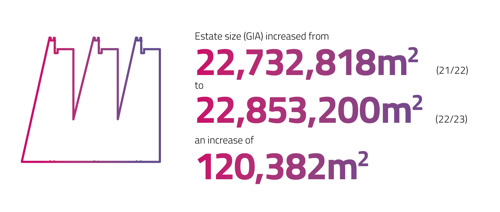The Higher Education Estates Management Report 2024 (EMR) is now available, and at a point where university finances have become headline news. As always the report creates benchmarking opportunities for university estates teams, and helps them understand long-term trends on estates income and expenditure.
If you have any questions regarding the EMR please contact info@aude.ac.uk
We are very pleased to be able to share today (17 January 2025) the publication of the new Estates Management Report 2024 (with insights from the 2022-23 academic year).
· Access the main report online
· Use EMR Digital- the interactive digital version of the report
In developing this year’s report it has never been more clear to us where we should focus. We are all looking at every decision through a lens of financial viability, as this year we have seen behind-closed-doors thinking on the toughest of financial calculations making its way into headline news. As the EMR demonstrates, property operating costs have shot up in recent years, including by 35% over a two-year period to 2023. This has been driven by steeply-rising energy costs (up 107% in two years) but by other factors too, including a rise of 45% in insurance costs during the year of this report alone. Such dramatic rises have left less for capital projects. Less for everything. For the second year in a row the total capital spend at our universities was £2.5bn. This figure has never recovered from the pre-pandemic height (£3.5bn in 2019). Tough choices face every institution, and as in every annual EMR report, the factual background to the entire theme is explored. Where does your institution sit when considering remedies? We’ve asked the behavioural economist Sir Roger Martin-Fagg, who many of you will know from provocative sessions at AUDE events, to steer us through the issues within the report.
As Professor Steven Spier, Vice Chancellor at Kingston University, and Caroline Harries, Chief Operating Officer at Kingston write in their introduction to this year’s report: “Such financial pressures often result in repairs and maintenance budgets being cut and capital investment paused. That is not a sustainable long-term position. A full review of what the infrastructure is needed for and when and how it can be optimised, will still necessitate investment to reach a more sustainable position. The amount of space required for teaching, offices, research, and innovation needs to reflect the changing needs of students and changing patterns of work. We need to consider smart campuses, be clear on the role of the campus, and use the physical estate all year round.”
This echoes the call at our recent Big Conversation event (Royal College of Music, November 2024) to “finally have the tough conversations about space”.
You will already be working on your own options – heat pumps, district decarbonisation schemes, a reduction in energy use and space (or at least better utilisation of the space you currently have). You’ll be factoring in issues of maintenance, and safety, with the government’s response to the Grenfell Tower Inquiry report due by March 2025, and the requirements of the Building Safety Act now live. You’ll be remembering sustainability commitments already made; and investigating technologies that drive all kinds of efficiencies.
AUDE Chair Syd Cottle emphasises the use of the EMR as a tool for joint decision-making at a senior level. “More than ever before the EMR deserves to be seen as a tool for collaboration between governance bodies, estates directors and university finance leaders. There are many moving parts in our financial calculations, not least the attractiveness to international students of a UK higher education. It’s vital that we do collaborate across campus so we can pool our perspectives and our knowledge to get to decisions that hold water.”
If this is the context, what are the actions for you and your team?
· The EMR always pays a close study. Use the pdf version or the digital tool to develop your understanding of your own position, perhaps in comparison to similar institutions. What can you learn from such benchmarking?
· We’ve noted a slow drift downwards in the overall condition of the HE estate. Revisit the plan. Are you at the point where you can no longer put off maintenance work? If so, how will you traffic that call through a system squeezed of funds?
· Gather your data, and particularly on energy usage and space utilisation. As property operating costs skyrocket, use the data in this report to support your identified options.
A final note on publishing this year’s EMR. We’d ask readers to consider the question we set on page 11 of the report, regarding depreciation as a property cost, and whether or not AUDE should show this from now on. It makes a fundamental difference to the way information is presented in the report (as it dramatically skews many of the trend graphs you are used to seeing) and we’d like your views on the way ahead.
The Sector



Property Costs






You do not have the required access level to view Latest Discussions, please contact your administrator
You can also find further EMR related discussions HERE